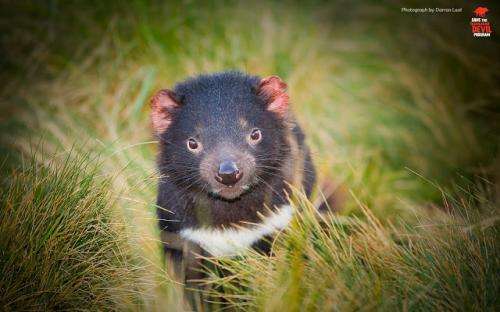October 31, 2016 report
Tasmanian devil milk found to have compounds with antibacterial properties

(Phys.org)—A team of researchers affiliated with several institutions in Australia has found that Tasmanian devil breast milk contains several types of antimicrobial peptides. In their paper published in the journal Scientific Reports, the team describes the study and what they found when they analyzed Tasmanian devil breast milk.
Tasmanian devils are fierce-looking little creatures that live only in Tasmania but have become famous worldwide due to their depiction in cartoons. In this new effort, the researchers report on obtaining milk samples from captive devils at the Devil Ark conservation facility, which serves to protect the marsupials. They report the devil mothers were milked by placing them in dark, bag-like coverings that exposed only their teats and then massaging the glands. The milk samples were then carried to a lab for study.
In analyzing the devils and their milk, the researchers found that they impart six types of cathelicidins to their young—these are compounds produced by the mother as part of a system meant to bolster the developing immune system of its young. The molecules are peptides that kill bacteria by causing damage to cell membranes. The researchers found them in the lining of the pouch where the young mature, in the skin of the mother and in the mother's breast milk. Altogether, they found six of them, which the researchers then synthesized for testing purposes. They found that two killed several types of bacteria that are harmful to humans, such as golden staph and enterococcus and Staphylococcus aureus, which is resistant to many current antibiotics. They also found that one of the cathelicidins was also effective at killing some types of fungi that infect human lungs and the central nervous system.
The next step for researchers will be testing the peptides to make sure they do not cause other problems in humans and then to tweak them to reduce production costs. If all works out, the compounds may soon be used to fight resistant bacteria and the harm they cause. The team in Australia is next planning to test other marsupials for cathelicidins to see if they may have peptides effective against other types of bacteria—next up is studying koala milk.
More information: Katrina M. Morris et al. Characterisation of the immune compounds in koala milk using a combined transcriptomic and proteomic approach, Scientific Reports (2016). DOI: 10.1038/srep35011
Abstract
Production of milk is a key characteristic of mammals, but the features of lactation vary greatly between monotreme, marsupial and eutherian mammals. Marsupials have a short gestation followed by a long lactation period, and milk constituents vary greatly across lactation. Marsupials are born immunologically naïve and rely on their mother's milk for immunological protection. Koalas (Phascolarctos cinereus) are an iconic Australian species that are increasingly threatened by disease. Here we use a mammary transcriptome, two milk proteomes and the koala genome to comprehensively characterise the protein components of koala milk across lactation, with a focus on immune constituents. The most abundant proteins were well-characterised milk proteins, including β-lactoglobulin and lactotransferrin. In the mammary transcriptome, 851 immune transcripts were expressed, including immunoglobulins and complement components. We identified many abundant antimicrobial peptides, as well as novel proteins with potential antimicrobial roles. We discovered that marsupial VELP is an ortholog of eutherian Glycam1, and likely has an antimicrobial function in milk. We also identified highly-abundant koala endogenous-retrovirus sequences, identifying a potential transmission route from mother to young. Characterising the immune components of milk is key to understanding protection of marsupial young, and the novel immune compounds identified may have applications in clinical research.
Journal information: Scientific Reports
© 2016 Phys.org

















